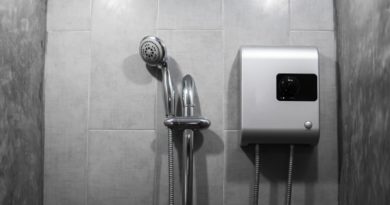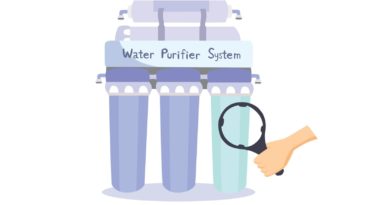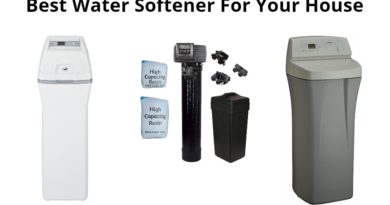DIY – How to Install a Water Softener
**Articles may contain links that I earn compensation for if clicked and you make a purchase. As an Amazon Associate, I earn from qualifying purchases. These earnings do not actually impact the price of the product or service.
Hard water can be damaging to your appliances and pipes, especially tankless water heaters, and just be downright annoying at times. There is a growing need for water softening systems in homes, and installing it yourself can help you save on installation costs. There are different difficulty levels of installing a water softening system depending on what type of pipes and system you have. For those that have some experience or feel comfortable with these types of projects will find that the task is not too difficult. We compiled this guide to help you through this process. Together we can tackle this home improvement project, but if you do not feel comfortable, professional help is always available.
Table of Contents
Different Types of Water Softening Systems
There are different types of water softening systems, which can vary in difficulty to install. If you are not familiar with piping or other projects like this one we highly recommend hiring a professional. The different types of water softening systems include:
- Salt-based Systems- This type of system is a mid-level to advanced installation. The way that the pipes connect can be extremely confusing to new users.
- Salt-free Systems- This type of system can range from an easy to advanced level depending on the type of salt-free system. Other factors include the types of pipes and the power source.
- Magnetic Systems- This type of system is the easiest to install. Almost anyone is able to install this type of system easily.
- Reverse Osmosis Systems- This type of system’s difficulty depends on the size and use of the system. RO systems have under-the-sink options or whole house options. The smaller option can be attempted by a DIYer, but the larger systems are more suited to be left for professional installation.
For all systems, be sure to check if your city or area requires you to obtain a permit. For those that do, always be sure to comply with all the regulations since they will most likely come to inspect it after. Before starting, always be sure to check with your city’s requirements since they do differ from place to place.
Essential Tools
The tools that you will need to complete the task include:
- Pipe cutters
- Pipe wrench
- Tape measure
- Tee valves
- Gate Valves
- Compressions fittings
- Tubing
- Union fittings
- Teflon tape
- Torch or solder
- Screwdriver
- Wrench
- PVC solvent
Some tools will not be required for easier systems. Always check with the manual before beginning. They will most likely tell you what tools you will need. If not, the list above should be sufficient to install any type of system.
How to Install a Water Softening System
Before you begin, always be sure to check the city and building codes of your area and building. Many places have specific requirements that need to be followed. The last thing you need is to finish just for them to tell you that you need to install an extra shut-off valve. Always be sure to check the manual before you begin as well. There should be detailed instructions and other warnings you may need to know.
Salt-Based Water
- A salt-based water system can be a bit tricky since it comes with a number of different parts. The main parts are the softener tank, brine tank, drain line, bypass valve, electronic head, and power supply. To start installing your salt-based water system, follow these steps.
- Turn off the water at the mainline of your house.
- Drain the water pipes using the lowest valve in your house and wait for the water to run out.
- Turn off your hot water heater and the power source as well.
- Find the location that you want to install the water softener. Make sure that the location you choose comes before the mainline enters the hot water heater.
- Using the pipe cutter, cut the mainline where you want to put the water softener. You can catch any water that drips out using a bucket to prevent a mess.
- Use the tape measure and measure the pipes that lead to the bypass valve. After measuring, you can cut the pipes and torch or solder any fittings before you connect the pipes.
- The system usually comes with two compression fittings, which you can use to attach the pipes.
- Using the hose clamp, tighten the hose to the system and set it up to feed to the drain. We recommend the hose be at least a couple of inches above the drain hole to prevent kickback of the water.
- The system will also come with an overflow tube that connects to the brine tank. The manual will usually let you know exactly where to place it, depending on the system you have.
- Turn the bypass valve to the open position and let the water run to remove any debris in the system. It is completely normal for there to be some.
- Lastly, plug in the power supply and reset the valve. Then open it up slowly to release the air and let in water. The manual will come with a flushing recommendation, and others have automatic systems.
If you have trouble with pressure or water supply, call for professional help to avoid a mess. If you followed all the steps, you should be ready to receive soft water for your home.
Salt-Free
A salt-free system is much easier to install compared to a salt-based water system since there is no need to refill salt.
- Turn off the water to your home at the mainline.
- Drain the water and let all the water run out before starting.
- Cut into the cold water supply pipe before it reaches the filter stage. You can do this by rotating the pipe cutter with a tight grip around the pipe.
- To the pipe, add a shut-off valve. You can do this by soldering it or securely gluing it to a PVC pipe.
- Add the carbon pre-filter using the compression fittings that usually come with the system. Check the manual for specific placement.
- This system needs a second shut-off valve placed after the pre-filter. To install this, simply attach it to the compression fitting provided.
- The system contains a downflow outlet. Connect the outlet back to the cold water pipe where the cut was made. This connects the water and lets it flow through the system before entering your house.
- Before turning on the main water valve for the house, be sure to turn off both shut off valves to let the water run through.
- Slowly check each valve, one at a time, to make sure there are no leaks. Tighten if there is any water dripping. If not, you are safe to open both valves and let the system do its work.
Like with all systems, be sure to check if your area calls for any specific requirements. If not, you are ready to get rid of the hard water in your home.
Magnetic
Magnetic systems are extremely easy to install, and the only tools you will need are an adjustable wrench and screwdriver.
- Find the location where you want to install the system. They are usually very compact since it relies on electricity to purify the water. You are able to place this almost anywhere.
- Read the instructions and open up the magnet box, which is the main component of the system. For most systems, it hinges in one direction. Use this side and clamp it down over the pipe with the wrench.
- Adjust the box to fit comfortably over the pipe and make sure the water flows in the right direction.
- The last step is to simply close the magnetic box and use the screwdriver to secure it to the location of your system.
It is as simple as that! With this system, you can save time and money on installation.
Reverse Osmosis
RO systems can vary in difficulty, so be sure to check whether or not this is a project you want to attempt before starting. We recommend larger whole-house systems leave it to the professionals since it includes large quantities of water that could cause a flood in your home.
- Turn off the water in the sink or location you want to place the system.
- Drain the water in this specific area before starting.
- The manual should let you know where to install the filter and carefully measure the wall or shelf where you want to put it. After measuring it, you can secure it using the screws provided.
- Install the saddle valve that comes with the filter into the cold water feed.
- Attach the water filter supply to fit inside the saddle valve.
- Cut the tubing with any sharp knife to fit the exact length you need. Then you are able to connect it to the other side of the filter.
- The system comes with supply and waste lines. Connect and shorten the lines with your knife to avoid any complications.
- Install the drain line adapter by cutting a hole into the waste line. Fit the line into the valve so that the water runs through the fitting before coming out of your faucet.
- Secure the storage tank depending on how you want to mount in and connect the supply lines on the system.
- Fill the system, then slowly turn on the faucet to check for leaks before using.
Final Remarks
Hard water is something you do not need in your home, and installing a water softener is something you can do yourself. When it comes to large amounts of water and tweaking your water lines, many people can shy away from the task. If you follow your system’s manual or the directions listed above, installing a water softener system can be done. Make sure to prepare everything before you start, and do not be afraid to call for professional help.


